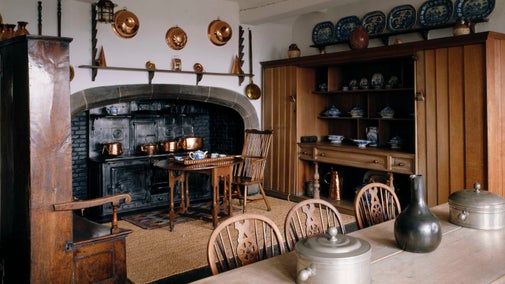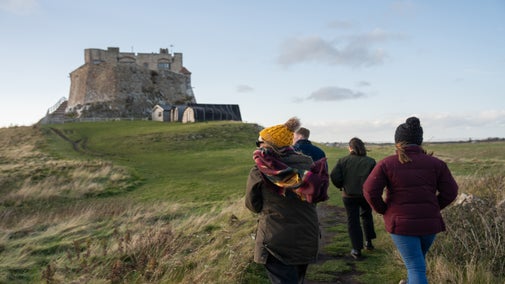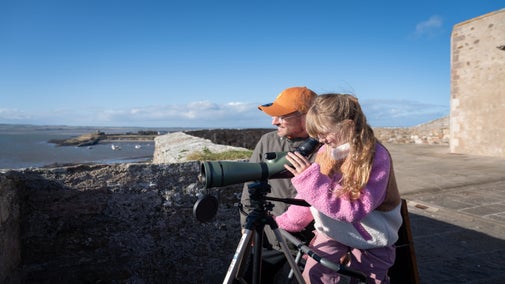
Discover more at Lindisfarne Castle
Find out when Lindisfarne Castle is open, how to get here, the things to see and do and more.

Discover the intriguing history of Lindisfarne Castle. Learn how the building was redesigned to become a windswept holiday home for Edward Hudson and cared for by dedicated housekeepers. Explore how the surrounding area was used to manufacture lime and uncover the secrets of its curious boat sheds.
Lindisfarne Castle’s origins go back to the old borderlands, and a time of religious and political upheaval.
From the 1550s up until 1893 the castle was garrisoned by the government, at one point mounting 21 cannons.
The castle was strategically vital during the Scottish Wars of the mid-1500s and later saw action in the Civil Wars and the Jacobite Rebellion of 1715.
Edward Hudson of Country Life magazine took on the lease in 1901. He commissioned the architect Edwin ‘Ned’ Lutyens and garden designer Gertrude ‘Bumps’ Jekyll to refurbish the castle to meet his taste. They were responsible for the most dramatic changes made to Lindisfarne Castle since the time of Elizabeth I.
In the first decades of the 20th century, Lutyens renovated the castle, while Jekyll made a planting plan for the garden and the castle surrounds. Together, their vision gave their patron Edward Hudson a comfortable – if slightly exposed – holiday home.
Hudson’s successors never made any major changes and so it’s largely the work of Lutyens and Jekyll that greets visitors today.
Ned Lutyens' architectural changes to the structure of the house are evident from his use of distinctive pink sandstone taken from the quarries at Doddington, near Wooler, on the mainland. Some older parts of the castle were taken down and rebuilt to include new features.
The eastern façade, which looks down on the Lower Battery (the visitors’ first sight on entering the castle) is mostly Tudor masonry. But it contains mullions around (and arches above) new windows, massive lintels above the doors and an entirely new semi-octagonal tower – all part of Ned’s plan.
Throughout the house Ned played with scale and space. He dressed small rooms with huge pieces of furniture, created seemingly unnecessary winding passages, added steps down followed by steps up and made low doorways in rooms with high ceilings. All these elements contribute to a remarkable architectural experience.
The collection of furniture was selected by Ned, mostly from Hudson’s property at previous houses, but he commissioned some too.
Lutyens also redesigned the walls of the enclosed garden but left what was inside to Gertrude Jekyll. Her first plan was for a vegetable garden but it was her second plan – a summer flower garden – that was planted in 1911. This plan is the one that the National Trust gardeners work to today.
Jekyll designed the garden to have a wealth of colour during the summer months and to be especially prolific in August. Flowers include eight varieties of sweet peas, two of which are the delicate 'Miss Wilmott' and the deep crimson 'Queen Alexander'.

During its period as a holiday home (c.1906–1968), Lindisfarne Castle had three different owners. These men all had different uses for it and welcomed different guests, but throughout this period there was one constant: the Lilburn family.
Jack and Hannah Lilburn began the three-generation relationship as housekeepers for the castle’s owners
Continuing in the tradition of most of the men on Holy Island before him, Jack Lilburn had always been a fisherman. All that changed when Edward Hudson came calling. Both Jack (known to Islanders as 'Wheeler') and his wife Hannah were to be employed as caretakers and housekeepers of Lindisfarne Castle.
Hannah looked after the castle itself and did most of the housework while Jack was responsible for maintenance and odd jobs, such as fetching coal or firewood.
Jack was also responsible for collecting Hudson's guests, including Lutyens and Jekyll, and delivering them to the castle. This involved driving a horse and cart from the railway station – usually at Beal but sometimes Chathill or Belford – and bringing them across the Holy Island sands.
If the tide was in, Jack often physically carried the visitors through shallow water into a boat and rowed them across from Ross Sands, near to where the two navigation beacons are, opposite the castle.
Edward Hudson was certainly very fond of Jack and Hannah, as well as their children George and Linda. These youngsters would eventually succeed their parents as keepers of the castle for the later owners.
Hudson wrote to Jack in December 1921, explaining that he had sold Lindisfarne Castle. He assured him that he would visit again, and that new owner Mr Falk didn’t wish to make any difference to Jack and Hannah's lives.
– Edward Hudson
Jack died in 1954 and Hannah followed him in 1956. They are both buried at St Mary's Church in the village. George's daughter Linda, the last Holy Island Lilburn, died in 2008.
Most people wouldn't associate the Holy Island of Lindisfarne with 19th-century industry, but it had a long-established lime-burning industry. Castle Point was the largest site on Holy Island, both in terms of the buildings themselves and the vast associated trackways and other features.
William Nicoll of Dundee, the lime merchant responsible for the kilns’ construction, had initially built kilns on land belonging to the Lord of the Manor, Henry Collingwood Selby, to the north-west of Holy Island village. After two years he had to vacate this site and move his operation to Castle Point.
This site was chosen as it lay outside the enclosed farmland, it was close to the harbour and it was easily connected to the quarry on the north shore of the island. Permission for the development was given on 24 March 1860. By the 1861 census there were 35 men employed at the kilns.
The principal features of the lime works are the kilns themselves, but the complex included much more. Wagonways snaked around the site, with earthworks, retaining walls, jetties, points, sidings, and even a bridge built under the eyes of the Royal Artillery in the castle.
We’re certain this system used steam locomotives, although ponies did most of the hard work. They hauled limestone from the jetties on the north shore, coal from the jetties, and the finished lime back to the waiting ships.
The men who worked at the kilns included quarrymen, lime burners, labourers, and carters. They came from all over the British Isles, with ex-navvies from Ireland and Scotland making up the bulk of the workforce.
This was a hot, smelly and dangerous job and men at the kilns often suffered caustic burns. Dust inhalation caused lung damage and, in some cases, could cause blindness.

Two types of lime were produced at the kilns – quicklime and slaked lime. These were used in a variety of industries.
Quicklime was used, for example, in making lime mortar; to create ‘limelight’ in theatres; and to destroy infected bodies and carcasses in burials. Meanwhile, slaked lime had uses including making whitewash, mortar and plaster; in water and sugar purification; and to neutralise acidic soil.
From the top of the kilns, limestone and coal were added to the pot (the brick-lined well) in layers. Once loaded – a process which took several days – the kilns were lit about halfway down the structure and the fire would spread upwards.
The limestone was reduced to powder, which then filtered through a grate below the fire and was removed via the drawing arches at the base of the kiln. As the limestone burnt down, more layers of stone and coal were added at the top. Slaked lime was produced by adding water to quicklime, resulting in a violent reaction.
By around 1870 William Nicoll’s business was not doing well, despite his investment and apparent prosperity. The following year he was packing up the operation – his ships’ records show that the vessels were laden with equipment from the site as well as lime.
By the 1880s the lime trade was in decline, and we think the Castle Point kilns were last fired in 1900 by an island farmer to make fertiliser.
Now a Scheduled Ancient Monument, the Castle Point lime kilns remain some of the best-preserved examples of their kind anywhere in country.
The tradition of using retired boats as sheds goes back centuries but it was particularly common in the 19th and early 20th centuries on the east coast of England. The sheds on Holy Island are probably the best surviving examples.
There are 12 boats at the harbour and three at the castle. Each has its own story to tell but the castle sheds have had a fascinating history since they were upturned.
Like most other visitors to the island, Edward Hudson was rather taken with the idea of boat sheds. He organised for two to be hauled up to the base of eastern elevation of the castle, probably in about 1905. A third shed was added in late 1912 or early 1913.
The seafaring theme is consistent with Lutyens’ scheme in the building. The shape of the boat hulls is reflected in the shape of the Ship Room (which Lutyens had initially called the Boat Room before the installation of a model ship) and several objects in the collection have a maritime link.
Custodians Jack and later George Lilburn would buy old keelboats from up and down the coast to satisfy the demand for firewood at the castle. Most of it would be stored in the sheds. During the 1950s we think the ageing retainer Robe Kyle occasionally spent the night in the top boat shed.
In the 1970s the Lilburn family wanted somewhere for their car and a proposal was put to the National Trust to convert one of the sheds into a garage. The presence of a lean-to garage on the lower level behind the sheds tells us that this proposal was thankfully rejected.
In 1980 the two sheds installed around 1905 collapsed under their own weight and were replaced with a Norwegian vessel, the Logresund. In the Second World War this boat had helped men flee Norway to Britain to join the Free Norwegian Army.
In 2005 the two sheds were destroyed by fire and again had to be replaced with two more, this time from a boat awaiting demolition at Leith. This vessel was very different: it was designed to hold an engine and propeller and so doesn’t have the distinctive deep keel of the original shed.
All three sheds have recently been repaired, mainly to make them water-tight, something that hadn’t been done even when they were at sea.

Find out when Lindisfarne Castle is open, how to get here, the things to see and do and more.
Lindisfarne Castle is now closed for the season and will reopen on 1 March 2026. The garden and grounds are open all year round. Step inside Lindisfarne Castle and uncover centuries of history on the Northumberland Coast.

Uncover the rich history and natural beauty surrounding Lindisfarne Castle on Holy Island. Wander through Gertrude Jekyll’s beautifully restored walled garden, and step back in time as you explore historic boat sheds and lime kilns—remnants of the island’s fascinating industrial past.

Lindisfarne Castle is now closed for the season, reopening on 1 March 2026. The garden and grounds are open all year round. Planning a family day out in Northumberland? Lindisfarne Castle on Holy Island offers a perfect mix of adventure and discovery for visitors of all ages.

Learn about people from the past, discover remarkable works of art and brush up on your knowledge of architecture and gardens.

Explore the objects and works of art we care for at Lindisfarne Castle on the National Trust Collections website.
